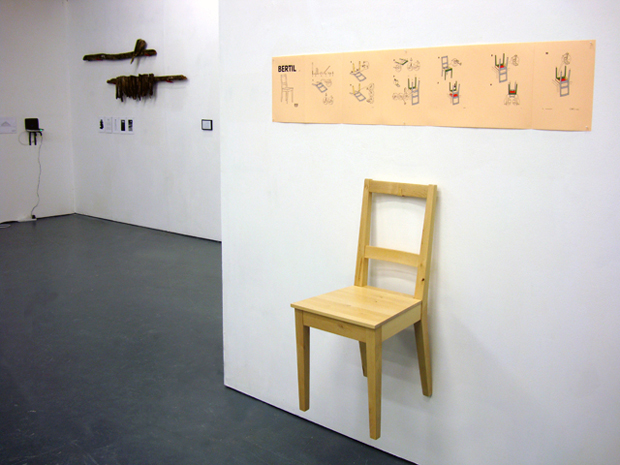![]()
+ BERTIL, 2014 by Peter Maloney and Michael Roberts
OBJECT AS MEASURE EXHIBITION 2014 [poster]
Group Exhibition, The Triangle Space Chelsea College of Arts, UAL, 30.01.14 - 13.02.14.
![]()
Exhibitors: Julia Dwyer+Sue Ridge, Takako Hasegaw, aEmma Hunter, Kristina Kotov, Robin Jenkins, Aaron McPeake, Michael Robertts+Peter Maloney, Martin Newth, Colin Priest, Peter Stickland, Ken Wilder, Stefan Willis, BA ISD Students
“All the human arts that involve time would be nothing without counting, measure and proportion”
Friedrich Kittler, Optische Medien, 1999.
Measure: verb. To ascertain the size, amount, or degree of (something) by using an instrument or device marked in standard units. Also: The rhythm of a piece of poetry or a piece of music.
Both architecture and music rely on mathematics and numbers - the essential elements of measure. While they may seem very different activities with wildly different aims, they share many qualities, terminologies, methodologies and processes. Through cross-disciplinary research and practice we have sought to explore and test parallels in the generation of material and musical form, from conception, to visualisation and to construction. Some initial questions were posed as the basis for our practical research and experiments:
• How can we measure space and/or form through music? How can spatial measure produce music?
• How can musical form become material/plastic form?
• How can musical and spatial practices combine to suggest new methods of practice?
We explored a range of spatial and temporal methods and approaches and we were interested in the notation used to construct or perform the work. We explored relationships between plan, section, elevation, orthographic projection, instruction and score. We have a shared interest in systems used to produce such notation. We were keen to allow for interpretation to play a part in the performance of such systems – towards open systems rather than closed.
Our aim was to produce a transferable or expandable open system to re-interpret and/or translate material or musical form. What you see here is the first outcome from this research. We are happy for the work to be seen as part of the current activity of IKEA - hacking: the re-interpretation, re-invention or re-imagination of existing Ikea furniture and other products into something new.
BERTIL 00:02:25”. [Download the MP3 file]

+ Bertil 2014 by Pete Maloney and Michael Roberts. [Photograph: Pete Maloney]
Method This harmonic restriction not only provides a pleasant tonal centre for the piece (C major/A minor), but middle C also acts as the literal tonal centre for the measurement procedure, with each component offered up to the keyboard symmetrically in relation to that central point. Pitch values are thus dependent upon how the components are constructed (e.g. the width of a chair leg was found to depress two adjoining keys), as well as how they are shown in relation to each other within the assembly instructions. This practical procedural decision exerts a basic contrapuntal compositional device (a sort of ‘contrary motion’) which in turn produces balanced motival form. |
|